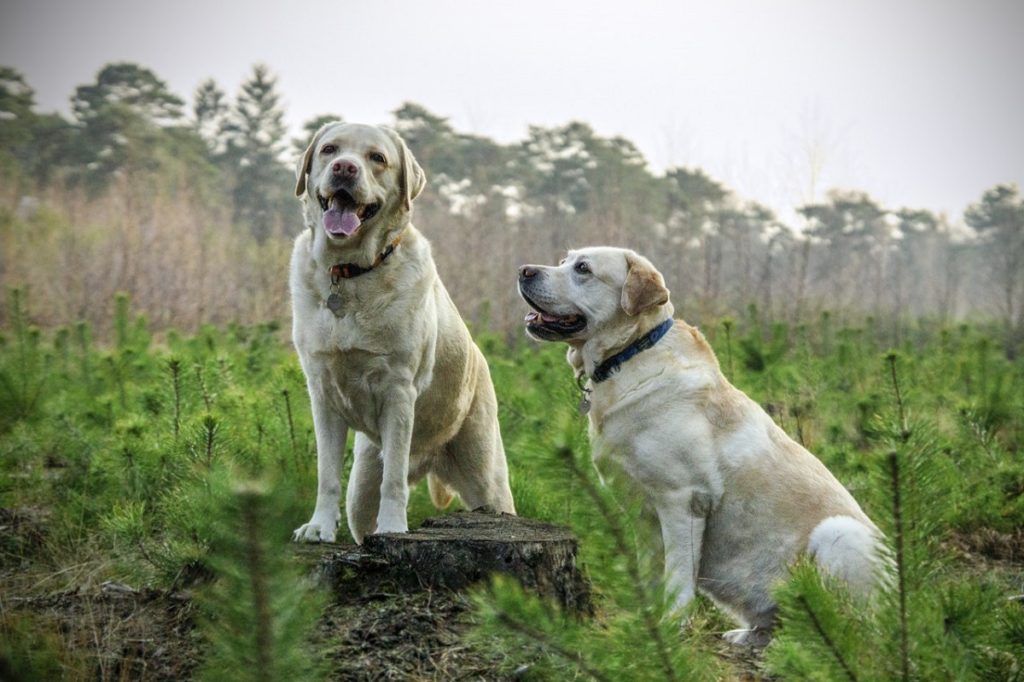Do you have a dominant dog on your hands? Some canines will display dominant behaviors as young puppies while others will not show signs of dominance until they are fully grown. Aggression resulting from dominance can be difficult to correct in some dogs and will require consistency, patience, and time commitment. To find out whether you have a dominant pet, learn more about the most common signs of dominant dog behavior here.
What Are the Most Common Dominant Dog Signs?
Dominance in dogs can be observed through a variety of different signs. Aggressive dominance should be taken seriously and can only be relieved through dedicated dog training and the potential use of medication. If your canine is exhibiting any of the following most common signs of dominant dog behavior, it’s a good idea to start thinking about corrective training.
The most common signs of dominant dog behavior include:
- Aggression toward small children
- Hostile responses to authority or eye contact
- Attempts to herd other animals or children
- Resistance to commands
- Guarding food or toys
- Obsessive licking
- Inappropriate mounting
Dominant dog behavior can become dangerous for small children. Aggressive dogs may nip or snap at a child’s head or neck. Children should always be supervised in the presence of a dominant canine.
Another common sign of dominant dog behavior is hostile responses to authoritative commands. Some dogs will be aggressive in response to verbal corrections. Others may view eye contact from people or other animals as a threat and will answer by barking, jumping up, biting, nipping, or pawing. Dominant dogs also tend to completely ignore commands and often refuse to vacate beds or couches at their owners’ request.
What Dogs Are the Most Dominant?
Although dominant dog behavior can occasionally be seen in young puppies, it usually develops when an animal reaches maturity. Aggressive temperaments will become apparent in dogs between eighteen months and three years of age and is more common in males than females. The most aggressive dog breeds include Chihuahuas, Dachshunds, Doberman Pinschers, Rottweilers, Pitbulls, Siberian Huskies, and Jack Russell Terriers.
Dogs will exhibit dominance around other animals, people, or both. However, many dogs will limit their aggressive dominance to other canines. You may notice that your pet is being disobedient, guarding food and toys, nipping, or biting in the presence of other dogs.
Causes of Dominant Dog Behavior
 It’s not uncommon for dominance aggression to appear in most dogs on occasion. This may occur while they are growing and maturing, but in most instances, it won’t develop into serious dominant dog behavior. However, certain circumstances can increase the chances of your pet developing ongoing dominance aggression.
It’s not uncommon for dominance aggression to appear in most dogs on occasion. This may occur while they are growing and maturing, but in most instances, it won’t develop into serious dominant dog behavior. However, certain circumstances can increase the chances of your pet developing ongoing dominance aggression.
Environmental Causes of Dominant Dog Behavior
Some pet owners provide their dogs with too much leeway at home which can cause dominance aggression to develop. In addition, pet parents that do not discipline their dogs when they are aggressive towards submissive animals may unintentionally intensify dominant behaviors.
Dominant Dog Behavior Caused by Lack of Socialization
Dominant dog behavior can be a result of puppies not being exposed to proper canine socialization. When pups are not properly socialized with well-tempered dogs in environments outside their home, they can become disoriented and frustrated. Dogs that lack adequate socialization won’t be able to read social cues and communicate with other animals. This leads to territorial aggression and can be a vicious cycle because aggressive canines are often kept isolated. As a dog ages, isolation will cause dominant dog behavior to intensify.
Genetic Predispositions that Cause Dominant Dog Behavior
Some canines may be genetically predisposed to developing dominant dog behavior. Dominance and aggression can be passed down through specific breeds. Some canine breeds have a specific need for a strong alpha as their owner. Otherwise, they will take on the role of alpha dog. Aggressive behaviors among dogs is usually a result of a lack of leadership. Without a pack leader, your pup’s need for dominance will be ignited. As a dog owner, you must establish respect and authority through firm rules, boundaries, and limitations. Constantly remind your pet that you are the pack leader.
Medical Causes of Dominant Dog Behavior
Certain medical conditions may trigger dominant behaviors and aggressive tendencies in dogs. Thyroid issues and testosterone imbalances are common medical causes of canine dominance. If your dog suddenly lashes out after being touched, it may be a cry for help. Many physiological disorders can cause chronic pain in dogs and irritability. Have your vet conduct a thorough exam to see if your pup is suffering from a medical cause of dominant dog behavior.
Diagnosing a Dog with Dominance Aggression
Dominance aggression can be dangerous and should be addressed by a professional. If your pet is exhibiting aggressive behaviors, a veterinarian will likely want to collect information about their behavioral history. Most vet clinics will request basic information including your dog’s breed, sex, age, and health record as well as the time of the onset of aggression. You should also document particular incidents when your dog shows dominant behavior and which circumstances trigger aggression. You may also need to provide information about recent changes to your pet’s diet or medication as well as any environmental adjustments.
A complete physical exam is typically performed by a veterinarian before diagnosing a dog with dominance aggression. The exam will involve diagnostic tests including blood count, urinalysis, biochemistry profile, and potentially tests evaluating the dog’s thyroid and testosterone levels.
Treatment for Dominant Dog Behavior
If your vet determines that your dog’s dominance aggression is caused by a medical issue, that condition will be treated first. Treatment for dominant dog behavior that is related to a medical condition will depend on the trigger of the aggression as well as the severity of the behavior. For cases of severe canine aggression, a safety muzzle may be recommended to prevent biting. Treatment for dominant dog behavior should be a collaborative effort between you and your vet or an animal behaviorist.
 Avoid scolding or physically punishing your dog when he exhibits dominant behaviors. Harsh punishments may increase the dominance and aggression. Providing your pup with more physical activity and regular obedience training can be an effective way to treat dominant dog behavior.
Avoid scolding or physically punishing your dog when he exhibits dominant behaviors. Harsh punishments may increase the dominance and aggression. Providing your pup with more physical activity and regular obedience training can be an effective way to treat dominant dog behavior.
In some instances, aggression issues and dominance may require psychiatric medications to help curb the behaviors. Anti-anxiety medications or antidepressants may be prescribed. Most psychiatric canine medications will take several weeks of use before improvement is noticed. Medications most commonly used to treat symptoms of dominant dog behavior are benzodiazepine derivatives and selective serotonin reuptake inhibitors. Specific drugs include Canine Xanax, Valium, Fluoxetine, Sertraline, and Prozac for dogs. Unfortunately, some dogs will become immune to the compounds in these medications making them less effective for long-term treatment.
When Dominant Dog Behavior Goes Unnoticed
Many signs of dominance aggression are obvious to pet owners, but many behaviors may go completely unnoticed. In most cases, dominant dog behavior will not develop overnight. Instead, it will unfold over time with signs building up over the years. Dominant dogs will not always growl or bite. When pet owners provide their dominant canines with what they want, there will be no reason for the dog to challenge their owners and exhibit aggressive behaviors.
Alpha Dog Behavior
When dominant pups are appeased by the humans around them, they will be under the impression that they are the alpha. A dog that considers themselves an alpha will bark, bite, and ignore commands. To prevent unsatisfactory dominance behaviors, it’s important for pet owners to maintain leadership with their dogs. When a dog believes he is an alpha, he will appear headstrong, stubborn, pushy, demanding, and physically dominant.
These temperaments can lead to some of the following behaviors:
- Nudging to be pet
- Bringing toys to their owners and begging to be played with
- Excessive guarding and watchdog behavior
- Possessiveness over their owner
- Unsolicited barking at people and animals
- High-pitched yelping or barking in objection to commands
- Jumping up on people
- Annoyance upon interruption from eating
- Going through doorways before their owner
- Stepping on the feet of others
- Sleeping on top of their owner
- Nipping at their owner’s heals when they leave home
- Refusal to wear a collar
- Pulling at their leash on walks
Body Language of Alpha Dog Behavior
If a dog perceives themselves as an alpha, they will demonstrate this higher rank in a variety of ways. This may include placing their paw on the shoulder or mouth of another animal, growling or snarling during playtime, persistent and focused eye contact, a proud walk with their head held high, erect or slightly tilted back ears, a show of teeth, or an upright tail.
Remember that an aggressive canine may display just a couple of the body language signs of dominant dog behavior. It’s important for pet owners to be aware of the signs so they can recognize them as they come up and react accordingly. Dog owners need to assume the role of pack leader. If this doesn’t happen, the dog will consider himself the alpha. Dominant dog behavior will make your pet think he makes the house rules and can do whatever he wants. This is a destructive and potentially dangerous path that should be avoided. If you address the signs of dominance before they elevate, you’ll have the best chance of preventing your dog from becoming overly aggressive.
Dominant dog behavior is one of the most challenging behavioral problems to curb in canines. In most cases, a professional dog trainer is your best bet for correcting the issue. If you go with an animal behaviorist, make sure they are certified in their respective field. Starting early with training will yield the best results and prevent long-term dominant behavioral issues. Also, when your puppy is young, it will be easier to make behavioral modifications and guide them to being a well-behaved adult dog.
Keep in mind that not all aggressive dog behaviors imply that a canine is dominant. Bad manners and improper training are often the cause of minor aggression. However, extreme cases of dominant dog behavior should be assessed by an animal behaviorist or vet who will be able to determine the best course of treatment. Pet owners should be aware of the dangers of dealing with a very dominant canine and take the situation seriously.




